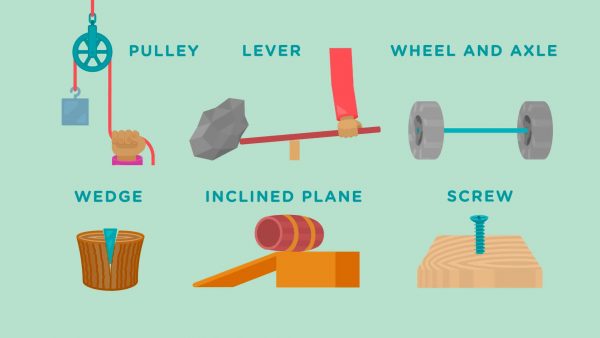Study Guide: Six Simple Machines
Vocabulary
- Simple Machines
- Inclined Plane
- Wedge
- Lever
- Pulley
- Screw
- Wheel and Axle
What are Simple Machines?
Throughout history, humans have developed devices to make work easier. The first of these are known as the “six simple machines”: the wheel and axle, lever, inclined plane, pulley, screw, and wedge, although the latter three are actually just extensions or combinations of the first three.
Other simple machines include ropes, chains, hinges, linkages, cranks, wheels, gears, and springs.
Simple machines are the foundation of more complex machines. They are combined to create new types of machines. For example, the inclined plane evolved into the wedge, which in turn became a screw when the wedge was coiled around a central rod.
Many of today’s complex tools are combinations of the six simple machines.
Why are Simple Machines Important?
Because work is defined as force acting on an object in the direction of motion, a machine makes work easier by accomplishing one or more of the following functions:
- Transferring a force from one place to another
- Changing the direction of a force
- Changing the magnitude of a force
- Changing the distance or speed of a force.
Incline Plane
A simple machine that has a gently sloped surface so it can be used to move objects upwards with less force. Ramps are examples of inclined planes. An inclined plane helps move heavy objects. It is easier to move heavy things up a ramp than it is to lift them straight up. A ramp is a common example of an inclined plane. It takes longer to go up, but it also takes less effort at any one point.
Wedge
A simple machine that gets thinner at one end that is used to split material such as wood. A wedge is a simple machine used to split material. By placing the thin end of the wedge onto a log, you can hit it with a hammer. The wedge changes the direction of the force and it pushes the log apart. A knife is an example of a wedge.
Lever
A lever is a plank that rests against something and can be moved up and down. A lever helps move heavy objects. When you push down on one side of a lever, the other side goes up. Levers can be used to lift heavy objects such as a rock or furniture. A seesaw is an example of a lever.
Pulley
A wheel and rope that can change the direction of a force. A flagpole uses a pulley to raise the flag. A pulley can move things from a low area to a higher one. A pulley has a wheel that allows you to change the direction of a force. As you pull down on the rope, the wheel turns and whatever is attached to the other end goes up.
Screw
A screw is an inclined plane wrapped around a central rod. An example of a screw is a spiral staircase. Another type of screw is a spiral staircase.
Wheel and Axle
Wheels and an axle reduce friction by allowing objects to roll over rough ground. The wheel is considered one of the most significant inventions in the history of humanity. Before the invention of the wheel around 3500 BCE, humans were limited in how much we could transport.
Questions
- An axe is a wedge that can be used to split a piece of wood.
- A knife is a wedge you use every day.
- You can also use a wedge to hold open a door.



